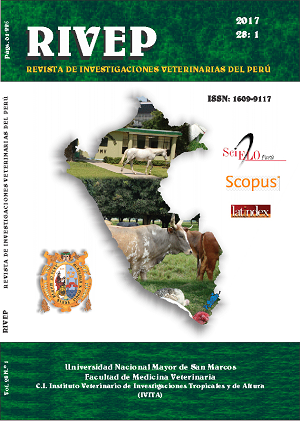Prevalence of bovine hepatic linguatuliasis in a slaughterhouse in Talca, Chile
DOI:
https://doi.org/10.15381/rivep.v28i1.12937Keywords:
Linguatula serrata, liver, cattle, public healthAbstract
The aim of this study was to determine the prevalence of hepatic linguatuliasis of cattle slaughtered in an abattoir in Talca, Chile. Livers (n=376) were examined and compatible lesions and the presence of the nymph of Linguatula serrata were recorded. The results showed that 13.8% of livers showed lesions compatible with linguatulosis and the etiologic diagnosis was obtained in 48% of them. No significant differences by age group (p=0.187) were found. In 28% of livers with etiologic diagnosis, linguatuliasis was the only parasitic disease, 60% was associated with liver fluke and in one case with one hydatid cyst. The prevalence of hepatic linguatuliasis was 6.7% based on the presence of L. serrata nymphs.Downloads
Downloads
Published
Issue
Section
License
Copyright (c) 2017 Miguel Carrillo Parraguez, Pamela Morales Muñoz, Francisco Carvallo Chaigneau, Cristina Abarca Garrido

This work is licensed under a Creative Commons Attribution-NonCommercial-ShareAlike 4.0 International License.
AUTHORS RETAIN THEIR RIGHTS:
a. Authors retain their trade mark rights and patent, and also on any process or procedure described in the article.
b. Authors retain their right to share, copy, distribute, perform and publicly communicate their article (eg, to place their article in an institutional repository or publish it in a book), with an acknowledgment of its initial publication in the Revista de Investigaciones Veterinarias del Perú (RIVEP).
c. Authors retain theirs right to make a subsequent publication of their work, to use the article or any part thereof (eg a compilation of his papers, lecture notes, thesis, or a book), always indicating the source of publication (the originator of the work, journal, volume, number and date).










